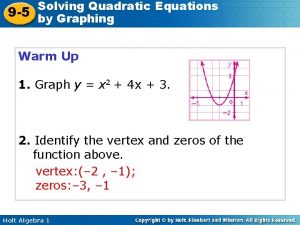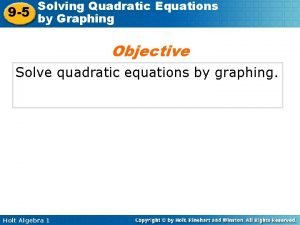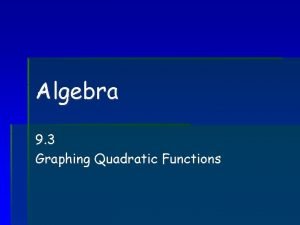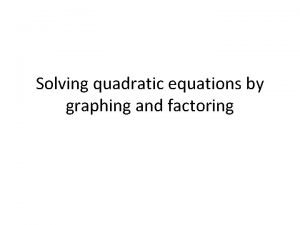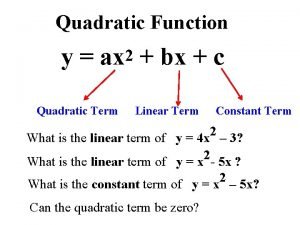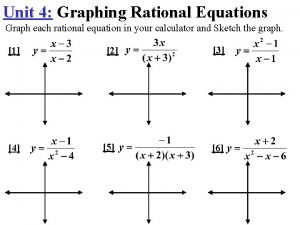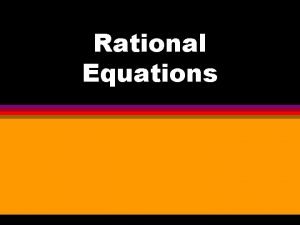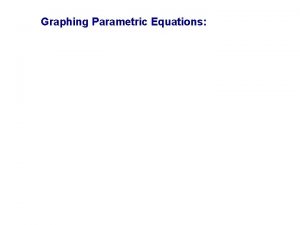Unit 4 Graphing Rational Equations Graph each rational






![Example 1: Sketch two possible graphs based on each description [A] Vertical: x = Example 1: Sketch two possible graphs based on each description [A] Vertical: x =](https://slidetodoc.com/presentation_image/27dc2da80bbbe32437cd149d5576d35d/image-7.jpg)





- Slides: 12

Unit 4: Graphing Rational Equations Graph each rational equation in your calculator and Sketch the graph. [1] [4] [2] [5] [3] [6]

Investigation: Graphing Rational Equations Observations based on the graphs #1 – 6: (1) What is different about these graphs from previous functions that you have drawn? (2) Is there any relationship you see between the numerator and/or denominator with the behavior of the graph?

Graphing Rational Equations By Hand Basic Steps 1. Factor Numerator and Denominator 2. Determine ZERO(S) of Denominator and Numerator 3. Determine the types of Asymptotes and Discontinuity (Use zeros to help) 4. DRAW Asymptotes 5. GRAPH based on known values or positive/negative sections

Special Behavior in Rational Equations #1: Vertical Asymptotes • x = a is a vertical asymptote if f(a) is undefined and a is a zero value of the denominator of f(x) only. • As x approaches a from the left or right side, f(x) approaches either ±∞ “Boundary you follow along” Vertical Asymptotes: Zeros of Denominator that do not cancel

Special Behavior in Rational Equations #2: Points of Discontinuity (Holes in Graph) • x = a is a point of discontinuity if f(a) is undefined • a is a zero value of the numerator and denominator of f(x). • Factor (x – a) can be reduced completely (cancel) from f(x) HOLES: Zeros of Denominator that cancel

Special Behavior in Rational Equations #3 Horizontal Asymptotes: • y = b is a horizontal asymptote if the end behavior of f(x) as x approaches positive or negative infinity is b. • Note: f(x) = b on a specific domain, but is predicted not approach farther left and farther right Case 1: Degree of denominator is LARGER than degree of numerator Horizontal Asymptote: y = 0 (x – axis) Case 2: Degree of denominator is SAME AS degree of numerator Horizontal Asymptote: y = fraction of LEADING coefficients Case 3: Degree of denominator is SMALLER than degree of numerator No Horizontal Asymptote: f(x) → ± ∞
![Example 1 Sketch two possible graphs based on each description A Vertical x Example 1: Sketch two possible graphs based on each description [A] Vertical: x =](https://slidetodoc.com/presentation_image/27dc2da80bbbe32437cd149d5576d35d/image-7.jpg)
Example 1: Sketch two possible graphs based on each description [A] Vertical: x = 2 Horizontal: y = - 3 Discontinuity: x = - 4 [2] Vertical: x = -4, x = 0 Horizontal: y = 0 Discontinuity: x = 2

Example 2: Determine the asymptotes and discontinuity values for the given rational equation and plot them on the given axes • FACTOR NUMERATOR AND DENOMINATOR!!!! a)

Example 2 b) Continued

Example 2: Continued c)

Example 3: Determine the asymptotes and discontinuity values for the given rational equation a) b)

c) d)
 Solve by graphing
Solve by graphing Graphing systems of nonlinear equations
Graphing systems of nonlinear equations Lesson 7 solve systems of equations by graphing
Lesson 7 solve systems of equations by graphing 9-5 solving quadratic equations by graphing
9-5 solving quadratic equations by graphing 9-5 solving quadratic equations by graphing
9-5 solving quadratic equations by graphing 9-5 solving quadratic equations by graphing
9-5 solving quadratic equations by graphing Lesson 7 - graphing radical equations and inequalities
Lesson 7 - graphing radical equations and inequalities 9-3 practice solving quadratic equations by graphing
9-3 practice solving quadratic equations by graphing 4-2 solving quadratic equations by graphing
4-2 solving quadratic equations by graphing Solving quadratic equations by graphing and factoring
Solving quadratic equations by graphing and factoring What is a x 2
What is a x 2 7-1 graphing systems of equations answers
7-1 graphing systems of equations answers Lesson 6-1 graphing systems of equations answers
Lesson 6-1 graphing systems of equations answers




